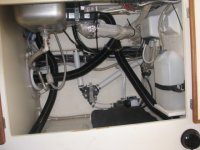beermanPDX
New member
- Joined
- Feb 1, 2012
- Messages
- 261
- Reaction score
- 0
I just got a new Webasto AT 2000 which I'll be installing in the galley cabinet. Obviously I'll be routing the exhaust directly through the side of the boat near the other thru-hulls (sink, head discharge). But I'm having a hard time figuring out where to route the combustion air intake. I don't want it too close to the exhaust or in a location in the cockpit where gas fumes may settle.
Can anyone who's installed a Webasto (or Espar / similar style furnace) tell me where they routed the combustion air intake? My kit comes with a second thru-hull for that. I've searched the threads and viewed install pics and I only see that mentioned once (Anna Leigh routed the intake from near the cockpit shelf). The only thru-hull pics I ever see are of the exhaust. I would have assumed that if people had to drill a 2nd hole through their boat, it would be photographed as much as the exhaust thru-hull. Hopefully people are routing combustion air from outside the cabin....right?
Again, I'm talking about combustion air intake, not cold air intake / return. The cold air return will be pulling from inside the cabin.
Thanks in advance.
Can anyone who's installed a Webasto (or Espar / similar style furnace) tell me where they routed the combustion air intake? My kit comes with a second thru-hull for that. I've searched the threads and viewed install pics and I only see that mentioned once (Anna Leigh routed the intake from near the cockpit shelf). The only thru-hull pics I ever see are of the exhaust. I would have assumed that if people had to drill a 2nd hole through their boat, it would be photographed as much as the exhaust thru-hull. Hopefully people are routing combustion air from outside the cabin....right?
Again, I'm talking about combustion air intake, not cold air intake / return. The cold air return will be pulling from inside the cabin.
Thanks in advance.



